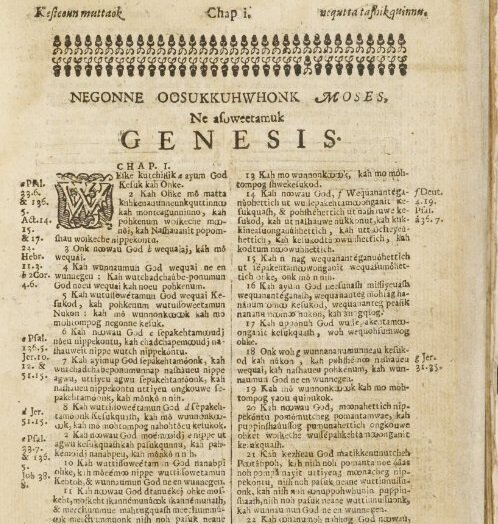
Indigenous peoples thrived along the Quinobequin/Charles River for thousands of years before the arrival of European colonists. In 1651, Rev. John Eliot settled Natick as the first “Praying Town” in the Massachusetts Bay Colony. Natick was incorporated as a town in 1781.
Natick’s Beginnings
Hand axe, Woodland culture, Natick Historical Society collections.
Indigenous people lived in this area long before Natick was established as a “Praying Town” in 1651. The Natick Historical Society's collections contain gouges, chisels, axes, projectile points, and other stone tools that tell us about the people who lived here up to 11,000 years ago. They are the ancient ancestors of the many Algonquian-speaking people who live in Massachusetts and beyond today. To learn more about the earliest inhabitants of this land, click here or here.
In 1651, Puritan missionary John Eliot worked with Indigenous leaders, such as Waban (Massachusett) and John Speen (Nipmuc), to establish Natick on a bend in the Charles River. Although the meaning of the word “Natick” is contested, many scholars agree that it originates from Algonquian words like "Nittauke" (Narragansett) and "Nutahkeem" (Wômpanâak), which translate to "my land" in English. The Algonquian speakers who already lived in the area of Natick represented many local clans and families associated with the Nipmuc and Massachusett nations.
Missionaries like John Eliot established praying towns to separate Native people from their traditional lifeways, spiritual traditions, and kinship networks so that they could work towards converting to the Puritan faith. Native people moved to praying towns for many reasons, including a desire for land security, economic survival, the possibility of English legal protection, and a curiosity about the Puritan faith during tremendous upheaval due to epidemics and English expansion. An essential part of the conversion process was accepting English customs and traditions, such as wearing English clothing and adopting English gender roles, such as men working in the fields. In Natick, people also learned English law, trade, and farming systems. For more than twenty years, Eliot visited Natick regularly to preach. Still, the town established its school led by Monequassan (Massachusett) and a government run by Massachusett and Nipmuc elected leaders. Indigenous people who moved to praying towns were called “Praying Indians.”
Natick residents built a wooden bridge with a stone foundation 80 feet long and 8 feet high across the Quinobequin/Charles River and established farms on both sides. Streets were laid along the north bank (now Eliot Street) and on the south side of the bridge (now Pleasant Street). They also built a meetinghouse with some guidance from an English carpenter. This two-story building was used as a church, school, and warehouse. Eliot, who lived in Roxbury, stayed in the meetinghouse when he visited Natick every two weeks. The meetinghouse was erected right about where the present Eliot Church stands, at Union Street and Eliot Street.
John Eliot preaching to the Indians, Indian History for Young Folks, 1919, Wikimedia Commons.
With the help of many Algonquian people, including Cockenoe (Montauk), Job Nesutan (Massachusett), John Sassamon (Massachusett), and James Printer (Nipmuc), Eliot oversaw a translation of the English Bible into the Algonquian language. The Bible they produced in 1663 was also the first Bible printed in British North America. A second edition of the Bible, printed in 1685, is held in the collections of the Natick Historical Society.
Natick’s prosperity suffered with the outbreak of King Philip’s War in 1675. English lawmakers restricted Algonquian people to their villages, making it difficult for them to farm or tend to livestock. Despite a protest from Eliot, in October 1675, the General Court of the Massachusetts Bay Colony ordered the internment of Natick’s residents, along with residents in 13 other praying towns, to Deer Island near Boston. Many did not survive due to the island's lack of food and shelter over a long, harsh winter. Many of those who survived and returned to Natick found their village and homes destroyed.
Before he died in 1690, Eliot ordained an Algonquian minister, Daniel Takawambpait, who was the church's leader until he died in 1716. John Neesnumin and Thomas Waban Jr. successively led the church for five years before the New England Company sent two Puritan ministers, Rev. Oliver Peabody, and later Rev. Stephen Badger, to fill the Natick church pulpit.
Algonquian people held much of the land in Natick in common until 1719, when 20 town men, including members of the Speen and Pegan families, were named proprietors to oversee any land division. By 1725, most original Indigenous landowners had been driven into debt and forced to sell their land. Over the 18th century, Natick changed from a predominantly Algonquian settlement into a town run by English and other European colonists. The Massachusetts government officially incorporated Natick as a town in 1781.
To read more about the history of the Nipmuc Nation and Massachusett Nation, please visit their websites here: The Nipmuc Nation, The Massachusett Nation.
Selected sources and additional reading:
Natick Historical Society collections.
Bacon, Oliver N. A History of Natick, From Its First Settlement in 1651 to the Present Time; With Notices of the First White Families. Boston: Damrell & Moore, Printers, 16 Devonshire Street, 1856.
Brooks, Lisa. Our Beloved Kin: A New History of King Philip’s War. New Haven, CT: Yale University Press, 2018.
Copplestone, J. Tremayne. John Eliot and the Indians: 1604-1690. The Estate of Eleanor D. Copplestone, 1998.
Crawford, Michael J. Natick: A History of Natick, Massachusetts. Natick, MA: Natick Historical Commission, 1978.
DeLucia, Christine M. Memory Lands: King Philip’s War and the Place of Violence in the Northeast. Yale University Press, 2018.
Mandell, Daniel R. King Philip’s War: Colonial Expansion, Native Resistance, and the End of Indian Sovereignty. Baltimore, MD: The Johns Hopkins University Press, 2010.
Morley, James W. From Many Backgrounds: The Heritage of the Eliot Church of South Natick. South Natick, MA: The Natick Historical Society, 2007.
O’Brien, Jean M. Dispossession by Degrees: Indian Land and Identity in Natick, Massachusetts, 1650-1790. Cambridge: Cambridge University Press, 1997.


